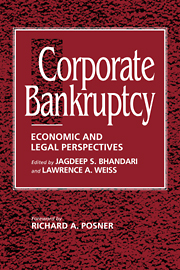Book contents
- Frontmatter
- Contents
- List of tables and figures
- Foreword by the HONORABLE RICHARD A. POSNER
- Preface
- Part I The role of credit
- Part II Bankruptcy as a reflection of the creditors' implicit bargain
- 4 A world without bankruptcy
- 5 Bankruptcy, nonbankruptcy entitlements, and the creditors' bargain
- 6 Translating assets and liabilities to the bankruptcy forum
- 7 Bankruptcy policy
- 8 Loss distribution, forum shopping, and bankruptcy: A reply to Warren
- Part III Beyond the basic creditors' bargain
- Part IV Workouts or bargaining in the shadow of bankruptcy
- Part V Alternatives to bankruptcy and the creditors' bargain
- Part VI Experience of other countries
- Index
7 - Bankruptcy policy
Published online by Cambridge University Press: 10 December 2009
- Frontmatter
- Contents
- List of tables and figures
- Foreword by the HONORABLE RICHARD A. POSNER
- Preface
- Part I The role of credit
- Part II Bankruptcy as a reflection of the creditors' implicit bargain
- 4 A world without bankruptcy
- 5 Bankruptcy, nonbankruptcy entitlements, and the creditors' bargain
- 6 Translating assets and liabilities to the bankruptcy forum
- 7 Bankruptcy policy
- 8 Loss distribution, forum shopping, and bankruptcy: A reply to Warren
- Part III Beyond the basic creditors' bargain
- Part IV Workouts or bargaining in the shadow of bankruptcy
- Part V Alternatives to bankruptcy and the creditors' bargain
- Part VI Experience of other countries
- Index
Summary
Bankruptcy is a booming business – in practice and in theory. From headlines about LTV's 10,000-page filing to feature stories about bankrupt consumers, bankruptcy has become an increasingly popular news item in the past few years. Both organized labor and the consumer credit industry made concerted efforts to put bankruptcy issues before the public in their recent pushes to amend the new Bankruptcy Code. Lawyers have been drawn to the bright lights. Firms that did not have a single bankruptcy practitioner five years ago now field large bankruptcy sections.
As bankruptcy has flourished in the popular press and in law practice, it enjoys what may be looked back on as a golden age in academe.
In the midst of this attention and noise and clamor, however, there is a quiet but persistent question: what function does bankruptcy serve? After the statutory arguments have been exhausted and the cases have been explored, most academic discussions of bankruptcy can be distilled to this question. Currently, the policies endorsed to support bankruptcy pronouncements are wide-ranging and, at the extremes, very much in opposition. Despite the critical importance of different policy presumptions, the policy elements underlying most discourses are asserted only obliquely, and they are rarely challenged directly.
Professor Douglas Baird and I have undertaken to debate in writing the basis of bankruptcy policy. In the belief that a good fight is far more interesting than a host of polite compliments and careful hedgings, Professor Baird and I undertake an aggressive and irreverent debate.
- Type
- Chapter
- Information
- Corporate BankruptcyEconomic and Legal Perspectives, pp. 73 - 94Publisher: Cambridge University PressPrint publication year: 1996
- 2
- Cited by



